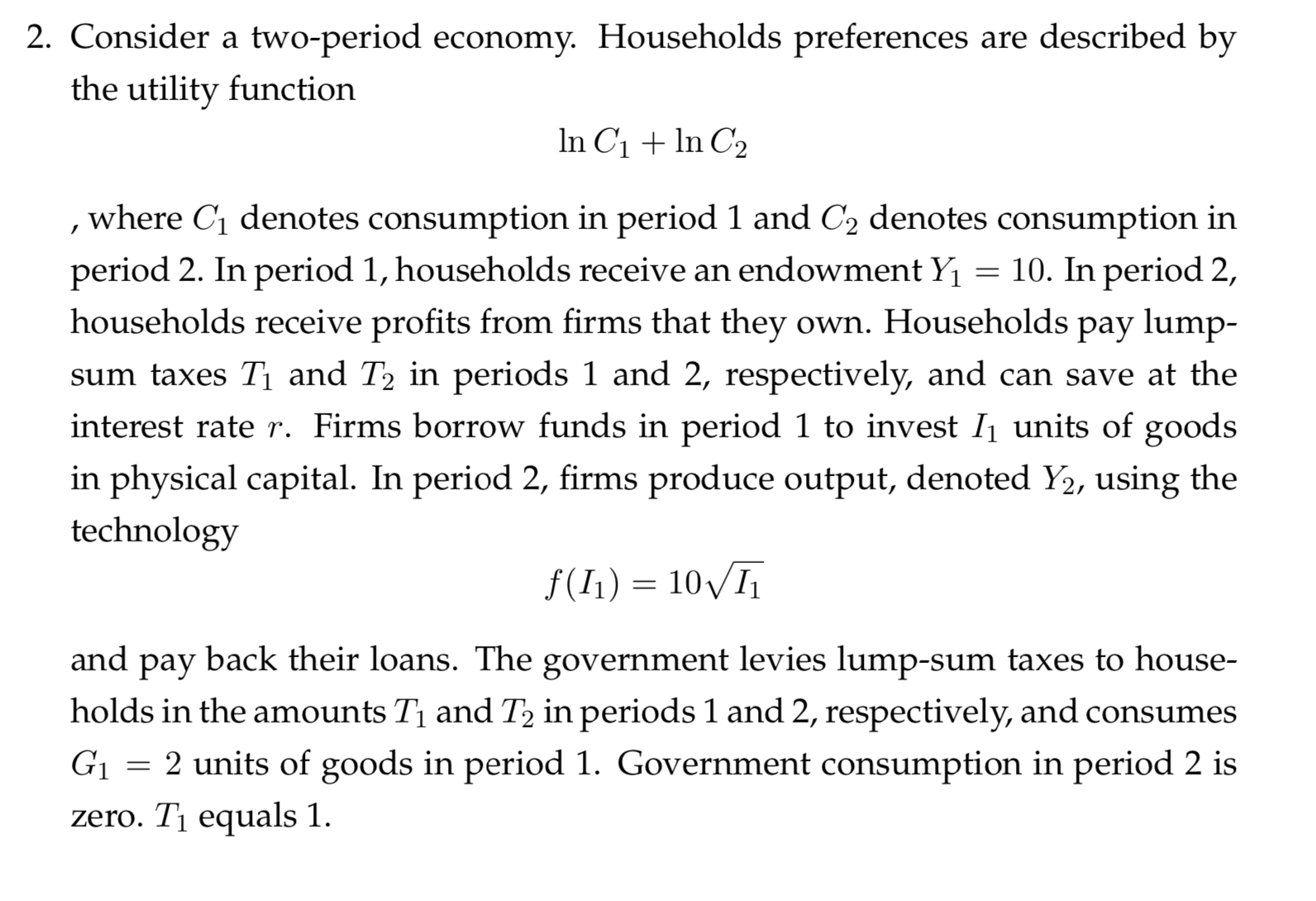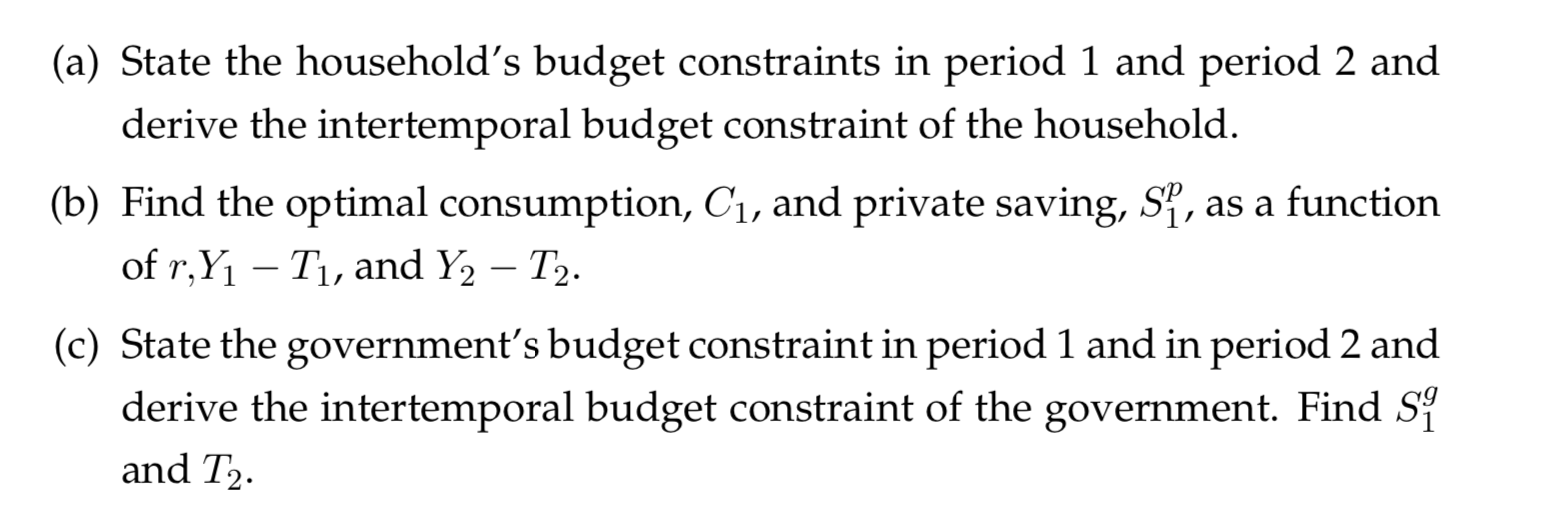2. Consider a two-period ecornomy. Households preferences are described by the utility function In C1n C2 , where C1 denotes consumption in period 1 and C2 denotes consumption in period 2. In period 1, households receive an endowment Y households receive profits from firms that they own. Households pay lump- = 10. In period 2, sum taxes Ti and T2 in periods 1 and 2, respectively, and can save at the interest rate r. Firms borrow funds in period 1 to invest I1 units of goods in physical capital. In period 2, firms produce output, denoted Y2, using the technology f(I1) 10I and back their loans. The government levies lump-sum taxes to house- рay holds in the amounts Ti and T2 in periods 1 and 2, respectively, and consumes G 2 units of goods in period 1. Government consumption in period 2 is zero. T1 equals 1. (a) State the household's budget constraints in period 1 and period 2 and derive the intertemporal budget constraint of the household. (b) Find the optimal consumption, Ci, and private saving, S, as a function of r,Y1 Ti, and Y2 T2. (c) State the government's budget constraint in period 1 and in period 2 and derive the intertemporal budget constraint of the government. Find Si and T2
2. Consider a two-period ecornomy. Households preferences are described by the utility function In C1n C2 , where C1 denotes consumption in period 1 and C2 denotes consumption in period 2. In period 1, households receive an endowment Y households receive profits from firms that they own. Households pay lump- = 10. In period 2, sum taxes Ti and T2 in periods 1 and 2, respectively, and can save at the interest rate r. Firms borrow funds in period 1 to invest I1 units of goods in physical capital. In period 2, firms produce output, denoted Y2, using the technology f(I1) 10I and back their loans. The government levies lump-sum taxes to house- рay holds in the amounts Ti and T2 in periods 1 and 2, respectively, and consumes G 2 units of goods in period 1. Government consumption in period 2 is zero. T1 equals 1. (a) State the household's budget constraints in period 1 and period 2 and derive the intertemporal budget constraint of the household. (b) Find the optimal consumption, Ci, and private saving, S, as a function of r,Y1 Ti, and Y2 T2. (c) State the government's budget constraint in period 1 and in period 2 and derive the intertemporal budget constraint of the government. Find Si and T2
Chapter17: Capital And Time
Section: Chapter Questions
Problem 17.1P
Related questions
Question
I need help with a-c

Transcribed Image Text:2. Consider a two-period ecornomy. Households preferences are described by
the utility function
In C1n C2
, where C1 denotes consumption in period 1 and C2 denotes consumption in
period 2. In period 1, households receive an endowment Y
households receive profits from firms that they own. Households pay lump-
= 10. In period 2,
sum taxes Ti and T2 in periods 1 and 2, respectively, and can save at the
interest rate r. Firms borrow funds in period 1 to invest I1 units of goods
in physical capital. In period 2, firms produce output, denoted Y2, using the
technology
f(I1) 10I
and
back their loans. The government levies lump-sum taxes to house-
рay
holds in the amounts Ti and T2 in periods 1 and 2, respectively, and consumes
G
2 units of goods in period 1. Government consumption in period 2 is
zero. T1 equals 1.

Transcribed Image Text:(a) State the household's budget constraints in period 1 and period 2 and
derive the intertemporal budget constraint of the household.
(b) Find the optimal consumption, Ci, and private saving, S, as a function
of r,Y1 Ti, and Y2 T2.
(c) State the government's budget constraint in period 1 and in period 2 and
derive the intertemporal budget constraint of the government. Find Si
and T2
Expert Solution
This question has been solved!
Explore an expertly crafted, step-by-step solution for a thorough understanding of key concepts.
This is a popular solution!
Trending now
This is a popular solution!
Step by step
Solved in 3 steps with 3 images

Knowledge Booster
Learn more about
Need a deep-dive on the concept behind this application? Look no further. Learn more about this topic, economics and related others by exploring similar questions and additional content below.Recommended textbooks for you

